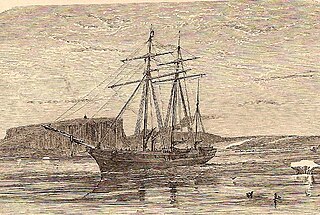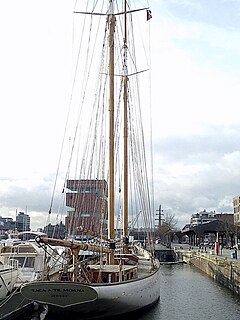
Palmyra Atoll, also referred to as Palmyra Island, is one of the Northern Line Islands. It is located almost due south of the Hawaiian Islands, roughly one-third of the way between Hawaii and American Samoa. The nearest continent is almost 3,355 miles to the northeast. The atoll is 4.6 sq mi (12 km2), lying in the equatorial Northern Pacific Ocean. Its 9 miles (14 km) of coastline has one anchorage known as West Lagoon.
Freedom (IX-43), an unclassified miscellaneous vessel, was the second ship of the United States Navy of that name. An auxiliary schooner, she was acquired by the Navy in 1940, and assigned to the United States Naval Academy where she served in a noncommissioned status through 1962.
USS El Cano (IX-79), an unclassified miscellaneous vessel, was the only ship of the United States Navy to be named for Elcano (PG-38). A schooner, she was acquired on 8 August 1942 as Pioneer, renamed El Cano on 17 August 1942, and served in a noncommissioned status in the 11th Naval District during World War II.
Geoanna was a steel auxiliary schooner built in 1934 by Craig Shipbuilding Company in Long Beach, California. Geoanna was requisitioned during World War II for service briefly with the U.S. Navy before transfer to the U.S. Army for Southwest Pacific operations. There Geoanna served as a United States Army Signal Corps communications ship with a mixed United States Army, Navy and Australian civilian crew through the New Guinea and Philippine campaigns. The ship remained in the Philippines after post war disposal.

Te Vega is a two-masted, gaff-rigged auxiliary schooner. Originally launched as the Etak, she was designed by New York naval architects Cox & Stevens in 1929 for American businessman Walter Graeme Ladd and his wife, Catherine ("Kate") Everit Macy Ladd. Etak was built at the Friedrich Krupp Germaniawerft shipyard in Kiel, Germany, and launched in 1930. During World War II she served the US Navy as Juniata (IX-77). She is among the largest steel-hulled schooners afloat.

The schooner Bowdoin was designed by William H. Hand, Jr., and built in 1921, in East Boothbay, Maine, at the Hodgdon Brothers Shipyard now known as Hodgdon Yachts. She is the only American schooner built specifically for Arctic exploration, and was designed under the direction of explorer Donald B. MacMillan. She has made 29 trips above the Arctic Circle in her life, three since she was acquired by the Maine Maritime Academy in 1988. She is currently owned by the Maine Maritime Academy, located in Castine, Maine, and is used for their sail training curriculum. She is named for Bowdoin College.

Crocker's sea snake is a species of venomous snake in the subfamily Hydrophiinae. The species L. crockeri is found in Oceania.
USS Volador (IX-59) was a wooden-hulled schooner acquired by the United States Navy in 1942 and after transfer to the United States Army seeing service in the Southwest Pacific Area during World War II as an early command and communications ship. The schooner was designed by William Gardiner and built at Wilmington, California by William Müller and Company in 1926. The yacht was owned by W. L. Valentine, a California yachtsman and Commodore of the California Yacht Club in 1931.

A steam yacht is a class of luxury or commercial yacht with primary or secondary steam propulsion in addition to the sails usually carried by yachts.
USS Onkahye was a schooner of the United States Navy. A unique ship in the American Navy under sail, the vessel occupied a significant place in ship development, being the only converted sailing yacht to serve on a distant station before the American Civil War. Its design was influential and it is considered the model for modern American sailing yachts.

HMS Blossom was an 18-gun Cormorant-class sloop-of-war. She was built in 1806 and is best known for the 1825–1828 expedition under Captain Beechey to the Pacific Ocean. She explored as far north as Point Barrow, Alaska, the furthest point into the Arctic any non-Inuit had been at the time. She was finally broken up in 1848.

Sea Cloud is a sailing cruise ship of the Sea Cloud Cruises line; as of 2020, it is the world's oldest oceangoing passenger ship. Launched as a private yacht in 1931, it served as a weather ship for the United States Coast Guard and United States Navy during World War II, when it became the U.S. military's first racially integrated warship since the American Civil War.

The Fox was an 1854 steam yacht commanded by Leopold McClintock on a privately funded 1857–1859 expedition to the North American Arctic Archipelago to search for clues about the fate of Franklin's lost expedition.

Matthew Turner was an American sea captain, shipbuilder and designer. He constructed 228 vessels, of which 154 were built in the Matthew Turner shipyard in Benicia. He built more sailing vessels than any other single shipbuilder in America, and can be considered "the 'grandaddy' of big time wooden shipbuilding on the Pacific Coast."

The St. Francis Yacht Club is a private sailing club located in San Francisco.
Result is a three-masted cargo schooner built in Carrickfergus in 1893. She was a working ship until 1967, and served for a short time in the Royal Navy as a Q-ship during World War I. She currently rests on land at the Ulster Folk and Transport Museum, and in 1996 was added to the National Register of Historic Vessels.

Valhalla RYS was a steam yacht, much admired in her day for her beauty and unusual rigging. She was famous for her participation in the Kaiser's Trans-Atlantic Race of 1905, and the sighting of a Sea-serpent in the Atlantic that same year. She had several owners, most notably Joe Laycock a trans-Atlantic racing yachtsman and Olympian, and Lord Crawford, who employed her as a research vessel on three major voyages from 1902 to 1908, which resulted in the book Three Voyages of a Naturalist : Being an Account of Many Little-Known Islands in Three Oceans Visited by the 'Valhalla' R.Y.S., by M.J. Nicoll, published in 1908. During the Great War she served with the Royal Navy as a part of the Eastern Mediterranean fleet's Aegean Squadron during the Gallipoli campaign. After the War she became a French-owned fruit carrier, before being wrecked off Cape St. Vincent in 1922.

The yacht Zaca A Te Moana is a schooner with fore-and-aft rig built in 1992 at Ouderkerk aan de Amstel, in Netherlands. The naval architect is Olivier Van Meer, and the interior architect is Ed Kastelein.
Charles Templeton Crocker was a past president of the California Historical Society and a member of the board of directors for over twenty years. He also wrote the first American opera that was produced in Europe; helped popularize French Art Deco in America; and funded and headed expeditions with the California Academy of Sciences and other academic institutions aboard his personal yacht Zaca. The town of Templeton is named after him.












